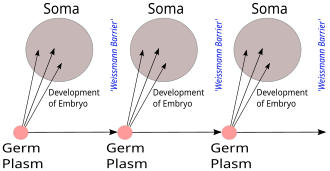

Germ plasm (German: Keimplasma) is a biological concept developed in the 19th century by the German biologist August Weismann. It states that heritable information is transmitted only by germ cells in the gonads (ovaries and testes), not by somatic cells. The related idea that information cannot pass from somatic cells to the germ line, contrary to Lamarckism, is called the Weismann barrier. To some extent this theory anticipated the development of modern genetics.